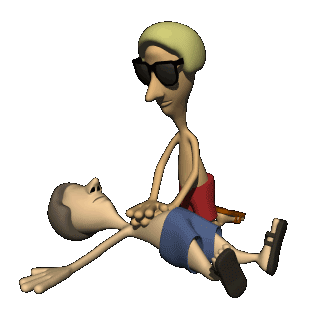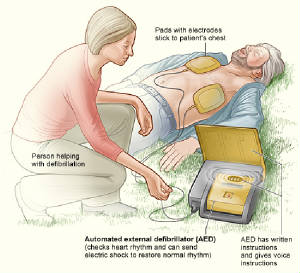|

CPR Steps
Cardiopulmonary resuscitation (CPR) can help save a life during a cardiac or breathing emergency. However, even after
training, remembering the CPR steps and administering them correctly can be a challenge. In order to help you help someone
in need, we've created this simple step-by-step guide that you can print up and place on your refrigerator, in your car, in
your bag or at your desk.
Before Giving CPR
1. Check the scene and the person. Make sure the scene is safe, then tap the person on the shoulder and shout "Are
you OK?" to ensure that the person needs help.
2. Call 911 for assistance. If it's evident that the person needs help, call (or ask a bystander to call) 911, then send
someone to get an AED. (If an AED is unavailable, or a there is no bystander to access it, stay with the victim, call 911
and begin administering assistance.)
3. Open the airway. With the person lying on his or her back, tilt the head back slightly to lift the chin.
4. Check for breathing. Listen carefully, for no more than 10 seconds, for sounds of breathing. (Occasional gasping sounds
do not equate to breathing.) If there is no breathing begin CPR.
Red Cross CPR Steps
1. Push hard, push fast. Place your hands, one on top of the other, in the middle of the chest. Use your body weight
to help you administer compressions that are at least 2 inches deep and delivered at a rate of at least 100 compressions per
minute.
2. Deliver rescue breaths (Optional). With the person's head tilted back slightly and the chin lifted, pinch the nose
shut and place your mouth over the person's mouth to make a complete seal. Blow into the person's mouth to make the chest
rise. Deliver two rescue breaths, then continue compression's.
Note: If the chest does not rise with the initial rescue breath, re-tilt the head before delivering the second breath.
If the chest doesn't rise with the second breath, the person may be choking. After each subsequent set of 100 chest compressions,
and before attempting breaths, look for an object and, if seen, remove it.
3. Continue CPR steps. Keep performing cycles of chest compressions and breathing until the person exhibits signs of
life, such as breathing, an AED becomes available, or EMS or a trained medical responder arrives on scene.
Note: End the cycles if the scene becomes unsafe or you cannot continue performing CPR due to exhaustion.

AED TRAINING
Before using an automated external defibrillator (AED) on someone who you think is having sudden cardiac arrest (SCA),
check him or her.
If you see a person suddenly collapse and pass out, or if you find a person already unconscious, confirm that the person
can't respond. Shout at and shake the person to make sure he or she isn't sleeping.
Never shake an infant or young child. Instead, you can pinch the child to try to wake him or her up.
Call 911 or have someone else call 911. If two rescuers are present, one can provide CPR (cardiopulmonary resuscitation)
while the other calls 911 and gets the AED.
Check the person's breathing and pulse. If breathing and pulse are absent or irregular, prepare to use the AED as soon
as possible. (SCA causes death if it's not treated within minutes.)
If no one knows how long the person has been unconscious, or if an AED isn't readily available, do 2 minutes of CPR. Then
use the AED (if you have one) to check the person.
After you use the AED, or if you don't have an AED, give CPR until emergency medical help arrives or until the person
begins to move. Try to limit pauses in CPR.
After 2 minutes of CPR, you can use the AED again to check the person's heart rhythm and give another shock, if needed.
If a shock isn't needed, continue CPR.
Using an Automated External Defibrillator
AEDs are user-friendly devices that untrained bystanders can use to save the life of someone having SCA.
Before using an AED, check for puddles or water near the person who is unconscious. Move him or her to a dry area, and
stay away from wetness when delivering shocks (water conducts electricity).
Turn on the AED's power. The device will give you step-by-step instructions. You'll hear voice prompts and see prompts
on a screen.
Expose the person's chest. If the person's chest is wet, dry it. AEDs have sticky pads with sensors called electrodes.
Apply the pads to the person's chest as pictured on the AED's instructions.
Place one pad on the right center of the person's chest above the nipple. Place the other pad slightly below the other
nipple and to the left of the ribcage.
Automated External Defibrillator
The image shows a typical setup using an automated external defibrillator (AED). The AED has step-by-step instructions
and voice prompts that enable an untrained bystander to correctly use the machine.
The image shows a typical setup using an automated external defibrillator (AED). The AED has step-by-step instructions
and voice prompts that enable an untrained bystander to correctly use the machine.
Make sure the sticky pads have good connection with the skin. If the connection isn't good, the machine may repeat the
phrase "check electrodes."
If the person has a lot of chest hair, you may have to trim it. (AEDs usually come with a kit that includes scissors and/or
a razor.) If the person is wearing a medication patch that's in the way, remove it and clean the medicine from the skin before
applying the sticky pads.
Remove metal necklaces and underwire bras. The metal may conduct electricity and cause burns. You can cut the center of
the bra and pull it away from the skin.
Check the person for implanted medical devices, such as a pacemaker or implantable cardioverter defibrillator. (The outline
of these devices is visible under the skin on the chest or abdomen, and the person may be wearing a medical alert bracelet.)
Also check for body piercings.
Move the defibrillator pads at least 1 inch away from implanted devices or piercings so the electric current can flow
freely between the pads.
Check that the wires from the electrodes are connected to the AED. Make sure no one is touching the person, and then press
the AED's "analyze" button. Stay clear while the machine checks the person's heart rhythm.
If a shock is needed, the AED will let you know when to deliver it. Stand clear of the person and make sure others are
clear before you push the AED's "shock" button.
Start or resume CPR until emergency medical help arrives or until the person begins to move. Stay with the person until
medical help arrives, and report all of the information you know about what has happened.
|

